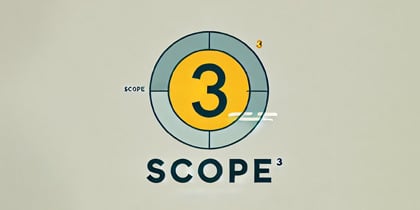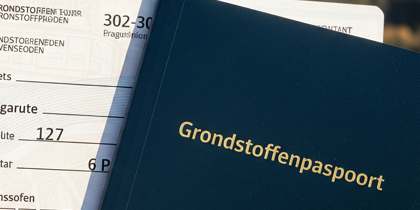The Digital Product Passport (DPP) aims to create transparency about what is in a product and how it can be reused or recycled. Something that is becoming increasingly important in the context of sustainability, circular economy and laws and regulations. In this blog you will read what the Digital Product Passport (DPP) is, whether it is already mandatory for your products and how it helps with ESRS reporting.
What is the Digital Product Passport (DPP) and how does it work?
The digital product passport (DPP) is a digital identity card for products. It can be found by scanning the QR code displayed on the product, on the packaging or in the manual..jpg?width=270&height=270&name=LinkedIn%20(80).jpg)
This QR code allows consumers to view basic information such as the product name and manufacturer. Producers, importers and distributors, after logging into a secure portal, can see more extensive information about the product's use of materials and how it is constructed. This makes it easier to properly repair, disassemble and recycle products. Not everyone has access to all the information in the passport because some of the data is company confidential or sensitive.
Is the Digital Product Passport mandatory and when does it apply to your products?
The Digital Product Passport is mandatory under the ESPR (ecodesign for sustainable products regulation). The ESPR, in force since July 2024, aims to ensure that products sold in the EU last longer, are easier to repair and can be better reused or recycled. The goal is to extend the life cycle of products and avoid wasting raw materials.
An important part of the ESPR is to make the Digital Product Passport mandatory. Each product must have a digital passport that records information on composition, origin, repair and recycling. The Digital Product Passport requirement does not yet apply to all products. The EU determines for each product group when the Digital Product Passport becomes mandatory. These agreements are laid down in so-called delegated acts. In April 2025, the first list of priorities was established. For these product groups, the obligations will apply first:
- textiles, aluminum and tires mandatoryfrom 2027;
- furniture mandatoryfrom 2028;
- mattresses mandatoryfrom 2029;
- metals.Here the rules will be further announced in 2026, with a transition period of 18 months. As a result, the Digital Product Passport for metal is likely to become mandatory from 2027/2028.
For batteries , the rules are specific: the Digital Product Passport will become mandatory for electric vehicles and industrial batteries above 2 kWh from February 2027.
How does the Digital Product Passport help with ESRS reporting and CSRD requirements?
The Corporate Sustainability Reporting Directive (CSRD) requires companies in Europe to report comprehensively on their impact on people and the environment. The European Sustainability Reporting Standards (ESRS) provide the guidelines for this: they define which topics must be covered and how that data is recorded. Among other things, companies must provide insight into their use of materials and energy, the origin of raw materials, CO2 emissions throughout the chain and the steps they take to reduce their impact.
Collecting the above information is often complex and time-consuming, as data is often scattered across suppliers and partners. The Digital Product Passport offers a solution to this. The passport records for each product what materials it contains, where they come from and how the product can be repaired or recycled. This data is collected and stored centrally in a digital system. Via a QR code or NFC tag, they can be accessed by anyone with the appropriate rights, so companies do not have to request the same data over and over again.
Using the Digital Product Passport for ESRS reporting is not mandatory, but it is a valuable tool. It gives companies one source of reliable product information, making the reporting process more efficient and orderly.
Read also

What is Scope 3?
What is the difference between the Digital Product Passport and the commodity passport?
The terms commodity passport and Digital Product Passport are often used interchangeably, but they are two different things.
For example, the materials or resource passport is best known in the construction industry. It records which materials have been used in a building or project so that they can be reused later. This passport was developed in the Netherlands, is not required by law and its content differs per project or client. It is therefore primarily a tool to encourage circular construction.
The Digital Product Passport (DPP) is different. This passport is part of European legislation (ESPR) and becomes mandatory for all products sold on the EU market. The goal is to standardize product information and make it digitally available to anyone with the appropriate rights. The DPP includes information on origin, environmental impact, repair and recycling in addition to material data.
The Digital Product Passport and resource scarcity: step toward a circular economy
The Digital Product Passport makes product information more accessible and helps companies to repair, recycle and reuse products. This is a step in the right direction, especially now that raw material scarcity is becoming increasingly urgent, according to research by Milgro. For example, half of Dutch companies (49%) expect raw material scarcity to result in higher prices for both products and services. They anticipate having to pass this cost increase on to their end customer. Nineteen percent of the companies are even so dependent on these raw materials that they see the current raw material scarcity as a concrete business risk. A quarter of the companies expect that organizations that do not invest in sustainability in the near future will disappear.
Stay informed
Want to stay up to date with the latest developments? Follow us on LinkedIn and Instagram or subscribe to our newsletter. Curious about what Milgro can do for your operations and waste process? Feel free to get in touch .
















